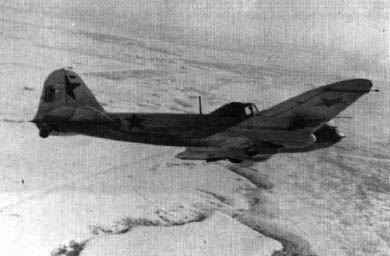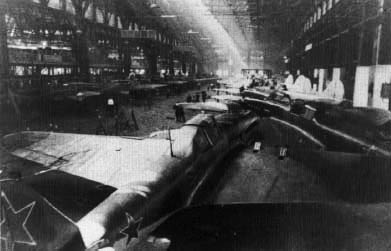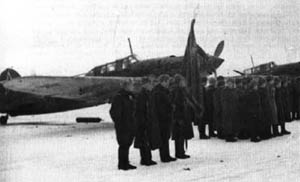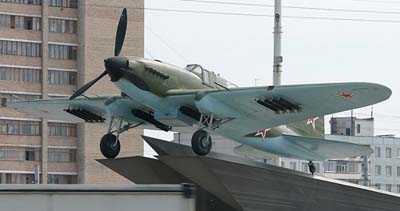 |
||||||
|
||||||
|
|||||||
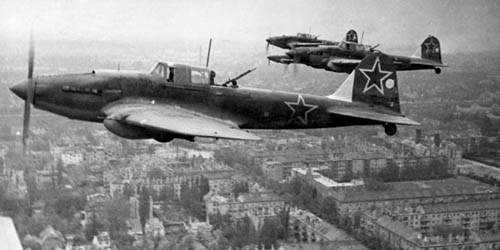 |
|||||||
| Il-2 Sturmovik | |||||||
The Ilyushin Il-2 Sturmovik, which turned out to be the most produced military aircraft of all time, goes back to a proposal made in January 1938 by Sergej V. Ilyushin for a “Winged Tank”. The first prototype, designated TsKB-55, took flight on October 2nd 1939. Unlike any plane before, the TsKB-55 was build around a armor shell, made of 4-5mm thick armor plates for the engine and even thicker for the pilot and gunner and even the canopy windows were armored. After problems with the cooling system had been resolved, an order for ten pre-production aircraft was issued, under the designation BSh-2, meaning Bronironwaniy Stormovik - Armoured battle aircraft. |
|||||||
|
|||||||
But Soviet Leadership preferred a single seat bomber which could penetrate enemy territory and ordered the Il-2 to be converted. The single- seater first flew on October 12th 1940 and showed improved flight characteristics. Because of reliability issues with the originally intended 7.62mm guns, the production variant included two 20mm cannons. This change to more powerful guns later became one of the key factors of the Il-2’s success. In January 1941, as production had started, the BSh-2 was renamed to Il-2. |
|||||||
|
|||||||
| When the Il-2 arrived at the frontlines, there were only few pilots trained to fly it, and none had test fired the weapons, which led to disastrous results in the first weeks, but as the Pilots got used to the Il-2, it proved quite successful. The German Wehrmacht was not prepared for this new enemy, that could easily destroy their armoured vehicles. Its rockets could destroy tanks with a single hit, but achieving that hit proved extremely difficult, so the cannons became the primary weapon of the Il-2. German ground soldiers feared the Il-2, and gave it nicknames such as “Der schwarze Tod” (the black death) or “Der Schlächter” (The Butcher). The soviet troops in contrast took a liking to the aircraft, which gave them such close support, calling it “the flying infantryman” or “the flying tank”. Because it could only be attacked on certain vulnerable spots, Luftwaffe pilots called the Il-2 “Betonvogel” (concrete bird), “Zementer” (concrete guy) or “Eiserner Gustav” (Iron Gustav). |
|||||||
|
|||||||
The original Il-2 was, in spite of its armour, very vulnerable to attack by enemy fighters as it was defenseless, if attacked from behind, leading to an unnecessarily high attrition rate. This prompted the engineers of many frontline squadrons to help themselves, by installing a provisional gun turret in the position behind the middle fuselage fuel tank. As a reaction, a two-seated version was developed, the Il-2M, which included a gunner position in the same position as field modifications had placed it. The rear gunners position was very spartanic, as any unnecessary equipment would have increased weight. The introduction of the rear gunner’s position proved a success in the beginning, but Luftwaffe pilots found ways to avoid it. Another problem was, that the rear gunner’s position changed the balance of the Il-2 and made it even more sluggish and hard to handle than it already was. This problem was fixed by a swept back outer wing section and resulted in the Type 3 or Il-2M-3, which became the definitive version of the Il-2. |
|||||||
|
|||||||
| A very unique version of the Il-2 was the Il-2M-82 (also known as Il-4): When the soviet factories were moved to behind the Ural mountains after the German attack on the Soviet union, Soviet officials feared a shortage of inline engines and ordered a modification of the Il-2 with the Shvetsov M-82 radial engine. A single Il-2 was modified. This version was based on the single-seater, and was refitted with the M-82 and a rear gunner seat. The new plane was labeled Il-4, but it proved inferior to the inline-engine powered Il-2, so it was cancelled, when it became clear that there would be no shortage of inline engines. After the end of the war, most Il-2’s in soviet service were quickly replaced by its predecessor, the Il-10, but a number of Il-2’s remained in active service deep into the fifties in allied countries. In these late days of its service, the Il-2 received the Nato codename “Bark”. |
|||||||
|
|||||||
| wingspan: 14.6m length: 11.6m height: 4.2m empty weight: 4.360kg max loaded weight: 6.160kg maximum speed: 414km/h range: 720km |
|||||||
| return to top | |||||||

